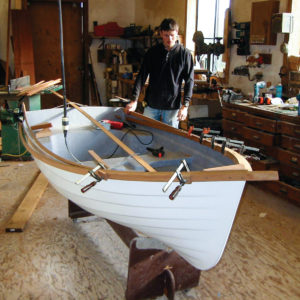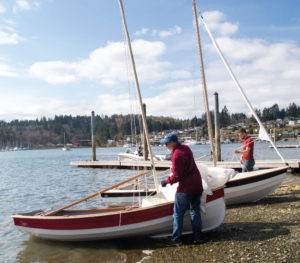This article originally appeared in the May 2021 issue of 48° North.
I confess to being a typical American in my shopping habits: I go to the store or browse the web, find what I want and buy it. The pandemic changed that dynamic. Remember toilet paper shortages? That critical item was followed by a shortage of flour, breakfast cereal, and other staples. No longer could I be confident that I’d be able to purchase what I wanted, when I wanted.
A year into the pandemic, I’ve gotten used to shortages and slowdowns. But how have these conditions been affecting the boat business? As consumer desires have shifted to solo or pod activities, like outdoor sports, I’ve heard that bigger boat sales have been healthy; but what about sales of little boats and their accessories? Wondering if their accessibility might drive demand, I spoke with several regional vendors to find out if a rising tide really does lift all boats.
“At first I thought, ‘We’re shutting down’,” Falk Bock told me. Instead, his building team at Gig Harbor Boat Works find themselves in full production mode: booked six months out since October 2020, they don’t see an end in sight. While sales have been steady, Bock hasn’t increased production. His team continues to construct three boats every two weeks, shipping them as far as Texas, Calgary, and New Zealand.
 “How do you go out and play, if you can’t hang out with other people?” Bock asked rhetorically. “You get a boat.” Gig Harbor’s line of small fiberglass boats has long been known for their tenders. But Bock reports that recent interest in self-contained voyaging craft like their fiberglass SCAMP with sails and oars has spurred a spike in sales. Bock was clear about his audience. “We’re not competing against paddleboards.”
“How do you go out and play, if you can’t hang out with other people?” Bock asked rhetorically. “You get a boat.” Gig Harbor’s line of small fiberglass boats has long been known for their tenders. But Bock reports that recent interest in self-contained voyaging craft like their fiberglass SCAMP with sails and oars has spurred a spike in sales. Bock was clear about his audience. “We’re not competing against paddleboards.”
At Duckworks Boatbuilders Supply in Port Townsend, Josh Colvin has also seen an increase in business. “It came as a surprise initially,” he said. “But we actually saw a spike, so sales are up. Apparently, if you’re forced to keep social distance, boat building and projects are not a bad way to spend the time.” Early in 2020, Colvin noticed an increase in sales of nitrile gloves and dust masks. “Eventually I figured out why, and I ended up freezing inventory and offering it to our local hospital.”
Currently, Colvin said, inventory is moving quickly at Duckworks, with basic supplies like epoxy and fiberglass cloth selling most briskly, along with specialty items, like collapsible oars.
Despite good sales, Colvin and other business owners I spoke with have experienced slowdowns in supply chains. Pandemic-related items like masks, gloves, and Tyvek aprons became difficult to find in 2020. “Many of our major vendors started shipping slower than usual,” Colvin told me. “In a few cases, our suppliers closed their doors temporarily because of COVID.”
Meanwhile, some in the business have not been affected by the pandemic. Eric Hvalsoe, a small boat designer, builder, and carpenter who works out of his shop in Shoreline, WA hasn’t noticed an impact. “It’s hard to say what normal is; there have been significant swings from year to year,” he said. “2020 will have been a good year [for me], and I don’t think COVID mattered much, one way or the other.” He added, “Business is typically random. Random has worked out well since the first part of last year.”
Given apparent demand elsewhere, curiously, Hvalsoe has not received a flurry of calls for his elegant wooden boats. He shrugged. “Maybe I’m a little surprised more people don’t talk to me about their dream boats. But the opportunity to build is rare. A boat of any detail or sophistication is a very high ticket item.”
about their dream boats. But the opportunity to build is rare. A boat of any detail or sophistication is a very high ticket item.”
With mass vaccination on the horizon, one has to wonder if the increase in sales and people on the water will continue. Falk Bock predicted a slowdown, but doesn’t think Gig Harbor’s market is flooded. “But used boats may be more prominent in the future,” he said.
Salty Sue of The Artful Sailor Nautical Supply in Port Townsend noticed “a trend toward more self-reliance and home and shipboard activities.” Many boaters already excel in these areas; others may have improved their skills during the lockdowns, while new sailors who took up boating during the pandemic may drive an increase in business for boat builders and suppliers.
Josh Colvin expects a resurgence of interest in sail and oar designs. “With technology racing ahead, I think the type of person attracted to sailing is also at least somewhat attracted to building something themselves and to boating without an engine,” he explained. “And small boats that can be singlehanded or sailed with two people make more sense right now than boats that require
a big crew.”
Colvin was also philosophical about the future, predicting that some of the ways we’ve been forced to change during the pandemic will end up lasting, to some degree. “Slowing down, working on projects, and getting out on the water might continue to be more popular
than before.”
If nothing else, let’s hope that getting out on the water more is a lasting result of our collective trials and tribulations with Covid-19.
Bruce Bateau
Bruce Bateau sails and rows traditional boats with a modern twist in Portland, Ore. His stories and adventures can be found at www.terrapintales.wordpress.com






